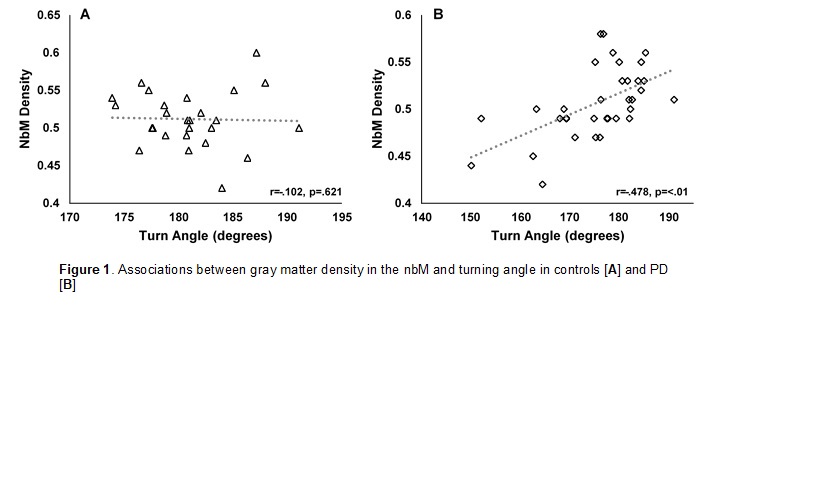Session Information
Date: Monday, October 8, 2018
Session Title: Parkinson's Disease: Cognition
Session Time: 1:15pm-2:45pm
Location: Hall 3FG
Objective: To examine whether turning during gait is associated with gray matter (GM) density of the nucleus basalis of Meynert (nbM) and attention in people with Parkinson’s disease (PWPD) and healthy older adults.
Background: Dopaminergic medication is beneficial for gait in PD, however some characteristics of gait, including turning, demonstrate a limited response (1). This suggests a non-dopaminergic neural contributor to gait. The role of acetylcholine in gait and balance, perhaps mediated by attention control, has shown promising results (2), however the role of acetylcholine in turning during gait has not been explored. The nbM degenerates in PD and is the main sources of cortical acetylcholine. We tested the hypothesis that nbM GM density is related to both attention and turning quality in PWPD.
Methods: Thirty-four idiopathic PD and 27 age-matched controls completed a two-minute gait assessment walking at their comfortable pace along a straight 7m walkway with several 180 degree turns. Gait was assessed ‘on’ medication. Characteristics of gait and turning were collected using body-worn inertial sensors (OPAL, APDM). Structural magnetic resonance imaging was performed on a Philips 3T Achieva MR System. We used voxel-based morphometry analysis to calculate nbM GM density. Participants also completed the attention network task (ANT) to assess orienting, conflict, and alerting domains of attention. Scatterplots and Pearson correlation analysis were used to assess associations.
Results: In PWPD there was a strong association between turning angle and nbM GM density in that sharper turns were correlated with reduced nbM GM density (r=.478, p=<.01; Figure 1) but no association was seen in healthy older adults (r=-.102, p=.621). Furthermore, the alerting domain of the ANT correlated with both nbM GM density (r=-.397, p<.05) and turn angle (r=-.355, p=<.05) in PWPD but not controls.
Conclusions: Results support our hypothesis that poorer cholinergic function in PD results in decreased attention related to decreased postural stability during turning.
References: 1. Curtze C, Nutt JG, Carlson-Kuhta P, Mancini M, Horak FB. Levodopa Is a Double-Edged Sword for Balance and Gait in People With Parkinson’s Disease. Mov Disord. 2015;30(10):1361-70. 2. Henderson EJ, Lord SR, Brodie MA, Gaunt DM, Lawrence AD, Close JCT, et al. Rivastigmine for gait stability in patients with Parkinson’s disease (ReSPonD): a randomised, double-blind, placebo-controlled, phase 2 trial. The Lancet Neurology. 2016;15(3):249-58.
To cite this abstract in AMA style:
R. Morris, T. Madhyastha, D. Martini, K. Smulders, J. Quinn, V. Kelly, K. Edwards, C. Zabetian, T. Grabowski, F. Horak. Turning during gait is associated with gray matter density of the nucleus basalis of Meynert in Parkinson’s disease [abstract]. Mov Disord. 2018; 33 (suppl 2). https://www.mdsabstracts.org/abstract/turning-during-gait-is-associated-with-gray-matter-density-of-the-nucleus-basalis-of-meynert-in-parkinsons-disease/. Accessed April 1, 2025.« Back to 2018 International Congress
MDS Abstracts - https://www.mdsabstracts.org/abstract/turning-during-gait-is-associated-with-gray-matter-density-of-the-nucleus-basalis-of-meynert-in-parkinsons-disease/

